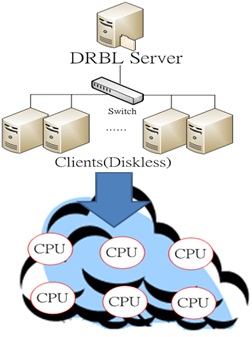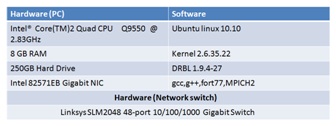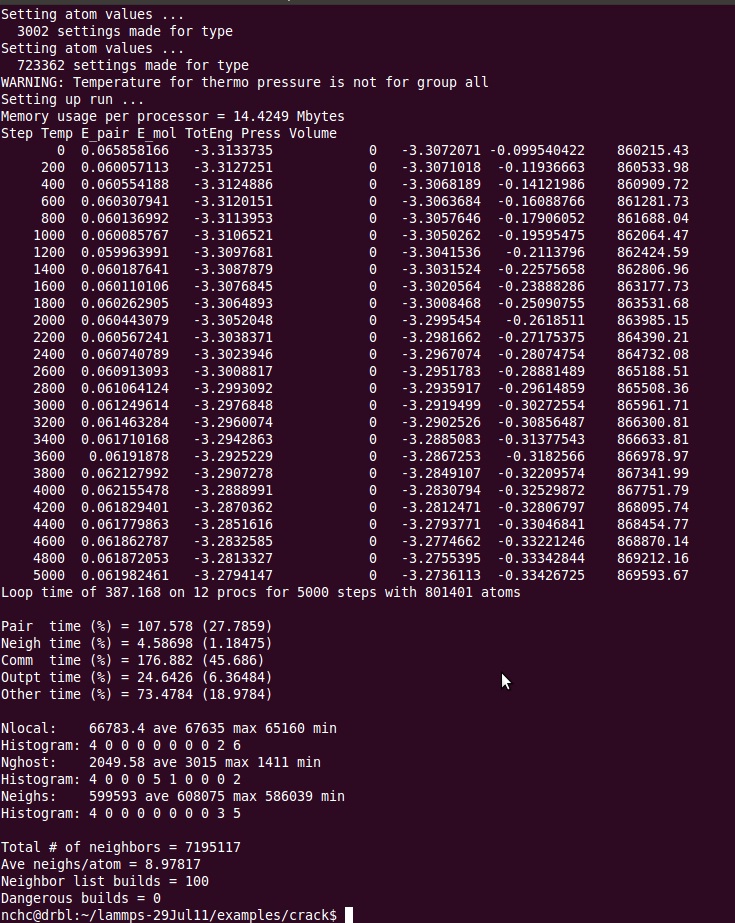2011/08/18已完成drbl-mpi.sh
DRBL-ONEMPI - A Toolkit for Deploying PC Cluster environment quickly and easily
Abstract―
The LAMMPS is classical molecular dynamics software which supports also large scale atomic massively parallel simulation.
The code has been run on a PC cluster with using DRBL (Diskless Remote Boot in Linux)-ONEMPI. MPICH2 provide an MPI
implementation that supports different computing and communication platform. How-ever, MPICH2 has still many installation
steps that are complicate. Therefore, the paper provides DRBL-ONEMPI free software to deploy desktop clusters. It can
construct quickly a multicores architecture environment and a convenient management for your environment. The DRBL-ONEMPI
gives user some useful installation process and assists system administrators to deploy their own private cluster
environment. We build a PC cluster environment, and runs in parallel using MPICH2 on our PC cluster with diskless nodes.
We will introduce the basic architecture of DRBL-ONEMPI and present some design.
Keywords―LAMMPS, molecular dynamics, MPICH2, DRBL-ONEMPI.
- Introduction
LAMMPS [1] is created by Sandia National Laboratories, a US Department of Energy labora-tory. LAMMPS is classical molecular
dynamics simulation software, integrates Newton`s equation of motion, is an open source code, and runs on sin-gle processors
or parallel programming with using message-passing interface. The LAMMPS source is widely applied in the semiconductors,
biomolecular, polymers, coarse-grained and microscopic, etc. It has been used to simulate in the chemistry and semiconductor
research. The LAMMPS has lots of library to use, modify, or extended LAMMPS in your choose.
In past few years, PC cluster are more and more popular in high performance computing be-cause of computing ability. However,
it is difficult for the administrator manage lots of computers, to deploy the system environmental and to configure the
installation of the cluster. The DRBL-ONEMPI provides a way to manage the pc cluster environ-ment, such as the installation
of the cluster, the deployment system environment, the user man-agement, the system monitor and easy to use it.
The DRBL-ONEMPI has two component packages including DRBL and ONEMPI. The DRBL is a diskless or systemless environment for
client machines and an open source solution to managing the deployment of the GNU/Linux oper-ating system across many clients.
Hence, we have an ideal plan for running MPI programming on the diskless environment and so to exploit ONEMPI. The ONEMPI make
user avoid complicated the MPICH2 [2] installation process. However, we combine DRBL with ONEMPI which rename DRBL-ONEMPI.
In general, the pc cluster is diffi-cult to manage and deploy environment. However, we use DRBL-ONEMPI to manage and execute
mpich2 on our computing environment. The user just enters some instructions on command-line that accomplish diskless environment.
In section.2, we will introduce LAMMPS si-mulation software. In section.3, the DRBL and ONEMPI system are presented in detail.
In section.4, the simulation process and benchmark results are discussed.
- LAMMPS Simulation
The LAMMPS has been used wildly in ma-terial processing, such as etching, deposition, sput-tering and surface cleaning, etc. some
people also use LAMMPS to apply mechanical engineering, such as computational fluid dynamics (CFD), Fracture Mechanics, Micro and
Nano Mechanics, etc. The LAMMPS is popular one of molecular dynamics software and lots of library.
The LAMMPS applied process as follows:
(1) To input a script file for LAMMPS the initial configuration.
(2) To create a particle and model types, such as atoms, coarse-grained particles, all-atom poly-mers, organic molecules,
proteins, DNA, etc.
(3) To choose force fields, the potential has Len-nard-Jones, Morse, Tersoff and EAM, etc.
(4) To construct boundary and constraints conditions.
(5) To choose integrators, such as velocity-Verlet integrator, Brownian dynamics, rigid body in-tegration, etc.
(6) To run program and Output file.
- DRBL and ONEMPI design architecture
- DRBL Architecture
Diskless Remote Boot in Linux [3] (DRBL) is an open source solution to managing the dep-loyment of the GNU/Linux operating system
across many clients. DRBL supports lots of popular GNU/Linux distributions, and it is developed based on diskless and systemless
environment for client machines. Figure 1 shows DRBL system architec-ture. DRBL uses PXE/Etherboot, DHCP, TFTP, NFS and NIS to
provide services to client machines, so it is not necessary to install GNU/Linux on the client hard drives individually. Users
just prepare a server machine for DRBL to be installed as a DRBL server, and follow the DRBL installation wizard to configure
and dispose the environment for client machines step by step. It’s really an easy job to deploy a DRBL environment on clustering
systems even for a GNU/Linux beginner, hence cross-platform and user-friendly are the key factors that make the DRBL become a
superior clustering tool [4-7]. DRBL can efficiently deploy diskless or diskfull cluster environment, and manage client. It configures
these services (TFTP, NIS, DHCP, and NFS) to build a cluster environment. According to this implementation, administrator just needs
two steps to deploy cluster environment. (1) Step 1: In-stalls DRBL packages and generates kernel and in-itrd for client;
(2) Step 2: setup environment para-meters, such IP address, and numbers of clients…. It also provides cluster management and cluster
system transformation (diskfull or diskless system). The Figure 1 shows DRBL system architecture.

Figure 1.Using DRBL on CPU Cluster
- ONEMPI Architecture
ONEMPI is a software package, and it de-pends on DRBL to deploy PC cluster environment. We are just run the ONEMPI script which is
build a PC cluster quickly. We employ to combine DRBL with ONEMPI to build a message-passing interface system environment. At first
we need to install configuration the DRBL software which is easy to install on operating system. Then, we run the ONEMPI script by
using super user when the DRBL is installed on ours system. The two steps is finished, users can execute and compile mpi pro-gramming
on the system environment. The ONEMPI script is automatically produce the “mpd.hosts” on yours home directory, and the mpd.hosts is
to record all nodes hostname and Pro-cessor numbers. However, the ONEMPI is achievement to realize the complicate installation process.
However, users can use the instruction “mpdboot -n * -f mpd.hosts” on yours home direc-tory, and the * is node numbers.
The Figure 1 shows ONEMPI architecture, and the ONEMPI script has two significance files as follows:
(1) The “mpi_install.sh” script is configuration to install software package (g++, fort77, gcc, mpich2, etc.) in the system, and create
the “mpd.conf” file to ours home directory.
(2) The “drbl_mpi_patch” script is to adjust the DRBL software, including the public key, creating the mpd.hosts file and DRBL
redeploy clients, etc.

Figure 2.ONEMPI design architecture
(3) We can run ONEMPI script file in the terminal command as follows:
Step 1: sudo ./install
(default : /opt/drbl-mpi)
Step 2: cd /opt/drbl-mpi/
Step 3: sudo ./drbl_mpi.sh
- System Environment Architecture
Table 1 shows the software packages about the diskless cluster. There are one server node and two client nodes in our system environment.
Server and clients have one Intel 2 Quad CPU Quad CPU Q9550 @ 2.83GHz and 8 Gbytes of memory. Ours system is Ubuntu 10.10 version.

Table 1.Hardware specifications and Software list
- Performance Results
We run one example within the LAMMPS software and obtain numerical the results. However, we use MPICH2 in the computing processes.
The crack propagation is one of LAMMPS software which uses in our environment system and to eva-luate the system performance. The example
1 of crack propagation is two-dimensional crack problem and using the Lennard-Jones potential to crack propagation simulation. The example
1 of crack parameter is following as:
Total timestep is 5000, number of atoms are 8141, the lattice constant is 0.93 Ǻ, the geometry is hexagonal lattices, the region is box
block and the length is 100 Ǻ, width is 40 Ǻ, etc. We can use the instruct on terminal as follows,
$mpirun -np 12 ~/lammps-29Jul11/src/lmp_g++ < in.crack. The figure 3 shows run the programming process and using 12 processes for crack problem.

Figure 3. The result of crack problem
The crack problem of total time is 384 second, communicate time is 176 second, output time is 24 second and other time is 73 times.
- Discussion and Conclusion
From our experimentation, we prove that the DRBL-ONEMPI is a great tool to help our dep-loyment environment system, and the system is convenient.
However, the DRBL has high network loading, owing to the bottleneck of high throughput I/O data communication and over-head, the DRBL architecture
is not suitable for I/O intensive applications. On the other hand, it brings a great benefit to those CPU intensive ap-plications with RAM disk.
The DRBL cluster is more and more popular because it is free software and the capability of powerful deployment. We can easy to build up a PC
high-performance dis-kless Linux cluster [8].
REFERENCE
[1] Sandia National Labs, “LAMMPS Molecular Dynamics Simulator”, http://lammps.sandia.gov
[2] Argonne National Lab, “MPICH2”, http://phase.hpcc.jp/mirrors/mpi/mpich2/index.htm
[3] National Center for High-Performance Computing, Taiwan, “DRBL(Diskless Re-mote Boot in Linux)”, http://drbl.sourceforge.net/
[4] Che- Yuan Tu ,wen-Chieh Kuo, Yao-Tsung Wang, Steven Shiau, “Building Energy Effi-cient ClassCloud using DRBL”, 10th IEEE/ACM International
Conference Grid Computing, 2009.
[5] Che-Yuan Tu, Wen-Chieh Kuo, Wei-Hua Teng, Yao-Tsung Wang, Steven Shiau, “A Power-Aware Cloud Architecture with Smart Metering”, 39th
International Conference on Parallel Processing Workshops, 2010.
[6] W. C. Kuo, C. Y. Tu, Y. T. Wang, “Deploy Kerrighed SSI Massively Using DRBL”, High Performance Computing and Grid, Asia, 2009.
[7] J. H. Shiau, Y. Hu, T. L. Lin , and K. L. Huang, “IMPLEMENT THE PIC-MCC SI-MULATION OF ECR PLASMA SOURCE ON PC CLUSTER WITH DRBL, AN EF-FECTIVE
APPROACH TO INTEGRATE PC CLUSTER”, Cellular Neural Networks and Their Applications, 2005 9th Internation-al Workshop on 28-30 May 2005 Page(s):311-314.
[8] Chao-Tung Yang; Ping-I Chen; Ya-Ling Chen, “Performance Evaluation of SLIM and DRBL Diskless PC Clusters on Fedora Core 3”, Parallel and Distributed
Computing, Ap-plications and Technologies, 2005. PDCAT 2005. Sixth International Conference on 05-08 Dec. 2005 Page(s):479-482.
Attachments (5)
- lammps.jpg (298.5 KB) - added by adherelinux 14 years ago.
- Hardware specifications and Software list.jpg (16.7 KB) - added by adherelinux 14 years ago.
- ONEMPI design architecture.jpg (33.1 KB) - added by adherelinux 14 years ago.
- Using DRBL on CPU Cluster.jpg (28.4 KB) - added by adherelinux 14 years ago.
- drbl-mpi.rar (4.8 KB) - added by adherelinux 14 years ago.
Download all attachments as: .zip
